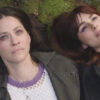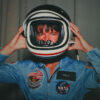“Documentary films are all about having some idea about the story you want to tell and then being surprised again and again over the course of the shoot,” says Jeff Dupre, director of “Kehinde Wiley: An Economy of Grace.” “This project had surprises built into the concept.”
Having last co-directed a portrait of the ever shape-shifting performance artist Marina Abramović during her famed exhibition at New York’s Museum of Modern Art with Matthew Akers (“The Artist is Present”), Dupre was ready for anything. But while the filmmaker could count on something new every day from his latest subject Kehinde Wiley, the Los Angeles-born, African-American painter who has shaken up the art world with his vivid, lush portraits that place modern subjects of color in the heroic context once afforded to kings and queens by Renaissance artisans, what he couldn’t expect was the two years and the countless visits to cities around the globe that it would take to fully realize his own portrait of the man, a larger than life figure in the midst of a great transition, painting women for the first time after a career of focusing on men.
Dupre’s film, named after the Wiley’s resulting collection of work “An Economy of Grace,” allows audiences to be immersed in Wiley’s world, a constant swirl of inspiration and extravagance. One minute Wiley’s in Israel or China preparing for a gallery opening, the next he’s on the streets of New York interviewing potential subjects for his next series, fitting in between a trip to Paris to Givenchy to nail down the details on the fitted gowns his subjects will be painted in. As Dupre chronicles, all of it is a long way from his birthplace of South Central Los Angeles where Wiley’s frequent escapes to the Huntington Gardens in Pasadena led to his eventual rechristening as an internationally renowned artist.
Yet just as Wiley’s canvases fuse the past and the present to feel undeniably of the moment, Dupre’s film is just as immediate, balancing the time spent in the surreal and rarefied air that the painter inhabits with equal consideration given to the subjects of his work who aren’t as accustomed to the spotlight and undergo a transformation of their own by being included in one of his works. The result is itself is a work of art, one recognized by the Academy’s documentary branch as one of the best shorts of the year to go by its inclusion on their shortlist of films that could be eventually nominated for an Oscar and recently, Dupre took the time to speak about the wild ride he took with Wiley and hanging on with every surprise that came his way. Also, since the film has been made available online by PBS, you can watch it right below.
[The gallerist] Sean Kelly represents Marina Abramović and I made a film about her called “The Artist is Present.” I met Kehinde through Marina and through Sean, who has a stable of artists who are all amazing. So Sean [explained] how Kehinde had always painted men and he was about to embark on a series where he was painting women for the first time and how it was time for him to challenge himself in that way and take on something new. I thought it sounded like a great idea for a film because the film about Marina was her getting ready for this show at MoMA, then with Kehinde, he also has this distinct process that he goes through when he does a new series of paintings.Kehinde was about a month away from going over to Paris to look at the paintings that would be the inspiration for “An Economy of Grace” and he asked me, do I want to go to Paris with him to walk around the Louvre? And I said sure. [laughs] Simultaneously, he was doing his street casting, so we would go out to Harlem or Brooklyn or Queens where he was just going up to people he thought were interesting and asked them if they’re interested in being in the painting. So we were off to the races. We filmed the street casting, we went to Paris, [where] he selected the paintings that would serve as the inspiration and met with Ricardo Tisci at Givenchy and filmed their collaboration, which was really interesting to see – a painter and one of the most renowned fashion designers in the world working together. That was great.
Is there something different about filming artists that you have to do to convey what makes them special to the screen?
The main thing you have to do as a filmmaker is attempt to create a work of art in response to their work of art. With someone as extraordinary as Marina, who has this unbelievable ability to create and project a mythology about herself, the film had to aspire to that mythological scale. With Kehinde, he’s the most incredibly vivid character and his work is so stunning that you have to make a film that is commensurate with that level of artistry, so that was the challenge. I can’t make something that’s dowdy. [laughs] It has to make a big impact.
Given his great attention to presentation and recontextualization, it seemed particularly poignant when you catch him getting a haircut. What was that moment like to film?
Yeah, the day when we filmed that scene, we went over to get him because we were going to go up to Harlem to film him doing a bunch of stuff at the museum. We got there a little bit early and [someone said], “Oh, he’s going to get his hair cut.” And I was like,”What!?! Great!” [laughs] Because I knew we would capture some kind of window into who he is. The barber was this really interesting guy and the conversation they just struck up conversation naturally was really revealing. He was this very kind of macho guy and Kehinde started asking him what he thought of his work and it was just really interesting to hear what he had to say because so much of Kehinde’s work is about shifting your perspective on gender, on race and on sexuality, so hearing it straight from the guy’s mouth was one of the great points of reference.

No, I feel like my job as a filmmaker is to create a portrait of him that’s true to my experience of him and to really let him speak for himself and let the film crystallize what his perspective is. And for him, his perspective shifts a lot. One stumbling block for a while was wondering, “Are you trying to capture who these women are and convey that to the world in the way that a Rembrandt [would], representing the souls of those people so effectively?” And for him, [the answer is], “No, that’s not what I’m doing. I’m actually creating this performance of self, so it’s not about authenticity. It’s not about these traditional ideas of a window into the soul.” That was something I didn’t quite understand at first, then I got it. When he started talking about “Paris is Burning,” the documentary, as something that meant a lot to him, that was a very interesting way in to understanding his work.
Did you feel he was at all apprehensive at first about letting you into his process, particularly at such a transitional moment for him as an artist?
He’s very self-assured. At first, it was different for him to have a giant camera and a sound man following him as he’s casting people, but he got over it very quickly. He knows how to put on a show whether the camera’s there or not. [laughs] He’s just an incredibly charming person, so you always consider yourself very lucky when the subject of your movie delivers the way he delivers.

It was a lot of travel. We also went to Miami with him for Art Basel, so not even everything is in the film. But he’s a globetrotter and it’s actually part of his process. He’s constantly out in the world absorbing so many different things, so many different ideas. And he likes to go to Paris and get inspiration at the Louvre and he has a studio in China, but he’s casting people in New York. He loves that global mix.
You mentioned the surprises. Did this turn out to be something different than what you envisioned it to be?
It’s a process film, so I knew there was going to be a beginning, middle and end. I knew what the steps would be along the way, but the things you never count on are the characters you’re going to meet and the way they make you laugh or make you think about things. Those are always the surprises and it was very moving and very interesting to get to know these women and to have this window into how the art world works and to get an inside look at an artist’s career and how it builds. It was just a real privilege.
“Kehinde Wiley: An Economy of Grace” is available on DVD or can be seen in full below.





